Review GSM phone Nokia 7270

Nokia 7270. Live pictures
Package:
- Handset
- Manual
- Disk with software
- Two textile covers
- Fabric bag
- Strap
- Stereo headset
- Charger

The Art-Deco collection includes three models and we have already introduced the youngest Nokia
7260 and the eldest Nokia 7280 to you, now it's turn
of the middle-class. Such positioning of Nokia 7270 as a middle-class model is possible only
in the Art-Deco line and comparing with other manufacturers we get a pure fashion phone of
high price category. Nokia 6170 is a prototype of the model and there you can also see metallic insertions on the front and back panels. The devices have similar body shapes and the feelings after using both are the same. It would seem why to manufacture a similar model with the same or even worse characteristics? The answer is in the beginning of the Nokia 7280 review where we discuss the positioning of the Art-Deco collection, presuppositions of its appearance and marketing. So, let's not repeat and start the story about Nokia 7270.

The design resembles the one of Nokia
7610 with splay corners and a combination of black and red on the internal surface. The plastic is black and lacquered, so fingerprints do stay on it but they are hardly noticeable. The plastic is the first difference from Nokia 6170. There it looks cheaper and is dull. The second difference is in the body form. The left bottom corner is round and that adds fun to the model.
Front and back panels are of metal. They are heterogeneous with a pattern engraved. The pattern makes perfect tactile feelings. And fingerprints are unnoticeable here.


Small hollows on the edges of the panels are striking. Projecting screw heads could have been expected but not the black gaps. They look misplaced in some way and break the whole composition but they are present because of the textile covers included into the kit. Two chamois covers are delivered, they are black and red. There are plastic projections for fixing the covers on the internal side of each one. You only need to press the cover and it'll be fixed with a low click. Having gained its "second skin" the device looks unordinary and differs greatly from all the other phones in the market.


The cover adjoins rather close to the body but when opening the device it cockles in the
area of the rotational mechanism. That's impossible to fight with and thus there is no
need. By the example of Nokia 7200 we know that textile covers get dirty rather quickly,
especially when the phone is carried in a pocket or in a bag that'll happen in about 30-40 days.
In Nokia
7200 the fact the covers are separated from the device is a considerable advantage. Even in 7200 they were stuck to the body items though removable (so, it looked like a sandwich of plastic and textile).
Any means for cleaning leather or a soft brush will surely suit for cleaning the cover. Washing in a washing machine is forbidden since the cover looses its original colour and the internal part gets shabby.

The covers are quite well-taken as design elements for this device. Other fashion stuff is a textile bag and a leather strap included into the kit. And more a charger has a holder for a wire in order you wouldn't entangle in it. The charger looks also stylish and differs from standard plastic boxes greatly.

The dimensions are larger than they should for a clamshell (88x46x22 mm) and the weight is 121 grams. It will go in a pocket but is not comfortable to carry this way. It's better in a jacket but not ideal. Well, probably, the dimensions are the worst disadvantage of the model. The weight is not as significant and even more, some people like heavy devices with metallic panels since they look more reliable.

Speaking about the hardware the device is very similar to Nokia 6170. So, an external screen is colour and shows 4096 colours (STN). The resolution is 96x65 pixels (25x19 mm). Various wall-papers and colour schemes may be set for the external screen. The screen always shows signal level, battery charge, information about the current events. A caller's photo may be displayed on it at the incoming call. Taking into consideration the little size of the screen and the fact the picture is shown on the one fourth of it you'll have to strain your imagination to recognize the caller by the picture. Why showing on the whole screen is not still realized is not clear.
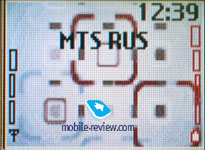

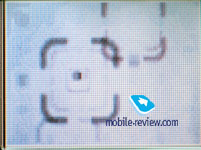

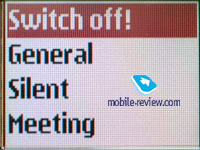

The fact the STN matrix gets blind in the sun is a disadvantage and the screen is not very good from this point of view. That's not accidental many Japanese manufacturers have recovered from the malady of integrating a colour external screen. Often a monochrome display is integrated or a colour but with a large diagonal (at least, TFT).
Working with the external screen is impossible with a closed device and that's a disadvantage. System notices are not meant here. They are certainly present. The fact we mean is that none of the side buttons allows working with necessary functions. For instance, there are two volume buttons on the left side and they adjust volume level. Let's transfer to the right side where a Push To Talk and On/Off buttons are placed on each side of an IrDA gap. Nokia users know that quick switching between profiles is assigned to the On/Off button but here changing them is impossible you'll have to open the device. And the same about the PTT function. A pressure and you see a dialog window but answering is possible only after opening the phone. These are the defects concerning the ideology of a usual phone of the classical form-factor and a shortage of experience in manufacturing clamshells tells upon. This disadvantage is not as serious and is not more than a slight roughness. That's curious the viewfinder on the external screen is activated from the menu and it can't be done by means of the hardware.
Side buttons are small and have little motion. They seem tight but really that's caused by their small size. The keys can't work accidentally in the majority of cases. There is a charger connector on the bottom end and a Pop-Port is also here.

The device may be opened with one hand (but little people will find that easy), there is some more plastic with stoppers on the top and bottom parts, they prevent parts from touching each other.

The internal screen is 65K TFT with the resolution of 128x160 pixels (31.7x38.9 mm). The picture is seen well. When compared to Motorola, Samsung, Sharp, Sony Ericsson the screen looses, but wins over Siemens and other Nokia models. The screen behaves well in the sun and fades not much. Up to 6 text and two service lines are shown. The grain is rather large and is noticeable when loading bright images (the device is better than last models by Siemens as for the grain size, thus it gets intermediate position).

The keypad is designed as a single block and some buttons are distinguished with edges that are not seen but are felt. Thanks to the body size the keypad was made large and comfortable. Keypad backlighting is white and seen well in many conditions. There is a 4D navi button with an OK one inscribed.

According to the manufacturer a 760 mAh Li-Ion battery works for about 4 hours in the talk mode and up to 270 hours in the standby mode. In Moscow the device worked for about 4 days in case of 10-15 minutes of talks a day and about 5-10 minutes of using other functions. When used more intensively the device will last for a bit less time and that will be about 3 days.

There is a clamping contact behind the back cover. It touches the metallic plate of the back cover and that is ground connection in some kind. When the phone is used a charge may appear on the metal and the device may go wrong accidentally. So, this earth connection is necessary for preventing this. As far as I remember that is the first phone with such an evident protection from static electricity.
Menu
The device is almost a complete copy of Nokia 6170 with only some new functions, a support for mp3, more memory and other pleasant trifles. A possibility of switching to other phone possibilities from this or that function is an advantage. For instance, when selecting a wall-paper image you look through all the folders and then from the Options menu called by the left soft-key you can set the picture or adjust its contrast. That's pleasant extra possibilities appeared but not that pleasant you have to confirm many actions that were done by a single press earlier. The feeling is ambiguous. On the one hand the possibilities widened on the other hand it takes more time to work with the menu now, not all the menus are designed logically that also causes troubles especially for unprepared users. I often caught myself at the thought that the phone lacks for Fast or context menu similar to the one that is used in the phones by Sony Ericsson. Selecting a menu item is assigned to the joystick press but not to the left soft-key.
The menu may be called by pressing the main key and the rows of icons may be seen in the main menu. Up to 9 icons may be displayed on the screen at the same time and if there are more of them (for example, SIM - Menu) you may use a scroll bar. The second way menu represented is a vertical list of icons and names of menu items.
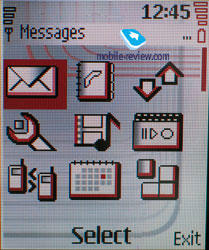
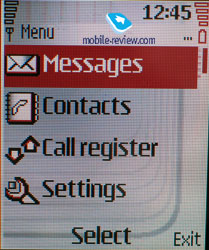
Moving the joystick in different directions calls this or that function quickly and that make the work with the phone easier. Any function (from the list) may be assigned to the left soft key and a list of the most frequently used menu items may be composed. Before considering separate functions we'd like to draw your attention to the distribution of memory. The total memory size is 15.5 MB and 14.5 MB are available to a user. The limit on the size of an application in the phone is 128 KB.

Phone book. It is possible to keep up to 500 names in the internal memory and it is the maximum number of entries. It is achievable if you enter not much information for a name, just one or two fields. And with medium filling, that is 6-7 fields for a name you may keep about 300 entries but not more. As it have already become clear it is possible to enter up to 5 numbers for a name and choose a type of the number (primary, mobile, home, office, fax). The first entered number becomes a default one and may be changed later if you wish. When entering the number for the first time, you type in only a name and one main number, all the other things are committed later from the edit menu. One may consider this not very comfortable, one will on the contrary say that keeps only one number for a name. Both will be right. Considering that similar input is realized in all the phones by Nokia, we'll surely say that it makes no troubles.
 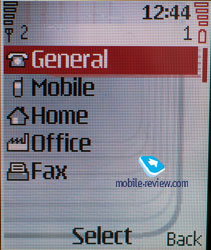
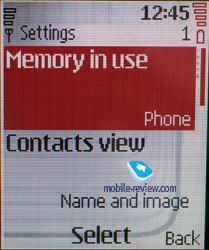 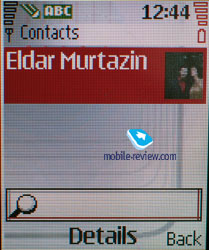
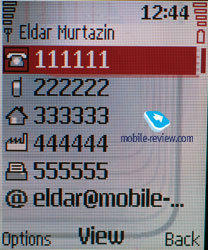 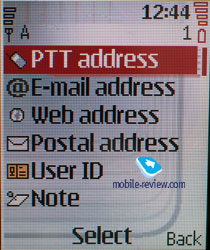
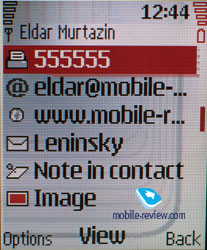

E-mail address, site url, post address and text note may be set as extra information to a number. The one new function should be pointed out, that is USER ID and it is user indication for the presence service. In general it is like an ICQ and signals that this or that user from your list is present or not at the moment. How interesting it will be is not still clear.
A photo may be added to a number (only portrait mode, changing the photo automatically to a corresponding size). When viewing the information on the name you won't see the photo automatically, you'll have to open a corresponding menu item for that. On the other hand, it is possible to set the view of a name and a corresponding image in the list. In that mode the icon is not large and doesn't give a good notion of the photo. Other modes of viewing the list are traditional - only names, names with the primary number. Numbers from both internal memory and SIM-card memory may be displayed in the main list.
There is a possibility to assign up to 10 voice tags for names from the phone book. The function works well even in the street. And traditionally the keys for speed dialing are from 2 to 9.
There is a possibility to assign up to 100 photos to names. During the incoming call the number and the photo of the caller are displayed. The picture is a bit larger than the one you see in the list but still smaller than it is necessary. You'll have to use your imagination to finally understand who is in the picture because a reduced photo has extra artifact. In general a photo takes a very small part of the screen and it is not explicable logically. At the moment realization of this function is the worst by Nokia among all the manufacturers and we hope that in future it will improve.
There are only 5 users' groups in the phone that is not typical for the phones by Nokia. And a special call melody may be set for a group.
Assessing the whole comfort of the phone book it is possible to say that it is average. On the one hand, there are a lot of fields in it, on the other hand its input capabilities are more convenient for working with a PC and not for the phone. I'd like to stress that the phone book in general is typical for the devices by Nokia and there are no any principal changes that means improvements. The widest possibilities of the phone book are represented in the phones by Siemens, then follow the devices by Sony Ericsson and only then Nokia.
Messages. The device supports Nokia's standard - Smart Messaging that allows sending and receiving melodies and simple black-and-white pictures from the compatible phones. Also the same standard is supported by Samsung, LG and some new devices by Motorola. There are up to 10 graphical templates in the internal memory especially for such messages. Unfortunately, the company's standard limits users because the alternative EMS standard, which is spread wider today, allows not only sending melodies and pictures but also format texts. In European countries EMS standard is very popular and ignoring it in the products by Nokia may be considered as a big disadvantage. In Russia only the most popular operators provide the technology and in the regions the presence or absence of this standard is not so critical. This may be disputable but the absence of EMS is still a minus for the phones by Nokia.
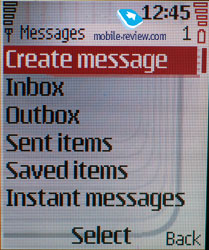
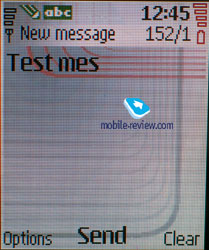
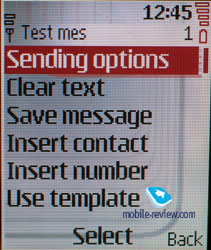
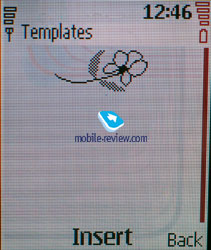

The company considers MMS possibility a complete substitute of EMS. And really this technology becomes ordinary and more interesting messages containing photos, colour images, melodies and so on may be created with its help. A message may be up to 100 KB in size. The realization of MMS in the phone is rather good, no any troubles appear with it.
 
The device has an integrated mail client that works with POP3/SMTP protocols. Its capabilities are extremely poor, attachments are not supported and the device accepts only one Russian coding. Due to the absence of any other alternatives one may use this mail client.
Call lists. There are three lists in the phone. Every list may contain up to 20 entries. And what is convenient that the date and time of the call are displayed in the list. Pressing the Call button in the standby mode, you get the list of the last dialed numbers.
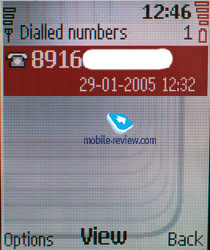
Settings. Profiles may be activated from this menu or switched quickly by pressing On/Off button. Every profile may be activated for a period of time and then the phone turns to the default profile. Sound alerts may be set for all the events, incoming call for all the calls or special users' groups. Realization of profiles in Nokia is one of the best on the market.
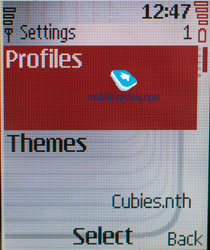 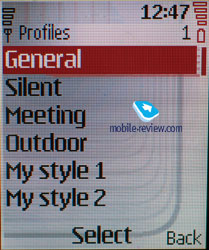
The screen settings allow choosing its color scheme, wallpaper and a screen saver. The screen saver is a picture that is displayed in the standby mode when the backlighting is not active. It is worth choosing one of the preset pictures, they are seen better in this mode than loaded full colour images. The interval may be set for the screen saver and then standard digital clock will take its place.

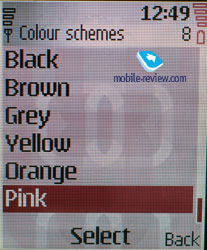
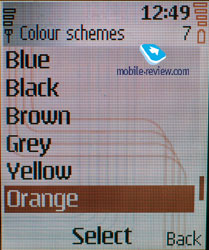 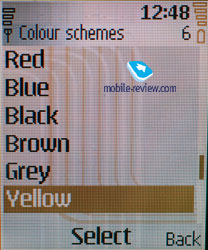
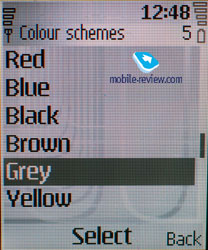 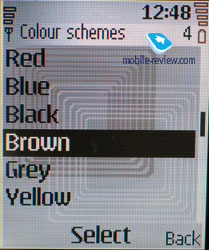
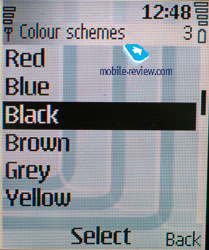 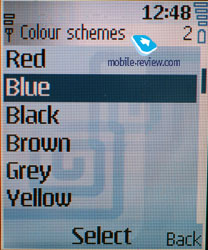
That is for the first time that a possibility to select not just an image but a whole folder for wall-papers appeared. You can't set time interval for the pictures change and that is about once in 10 seconds by default. The function varies dealing with the device and the picture makes tired not as fast.

There is an automatic key lock in the phone, you also may set a special security code in order to nobody could use your phone. A possibility to set the behaviour of the phone from the beginning appeared for accessories, for example, to choose a profile that becomes active when connecting a handsfree headset or a charging device. It is an interesting possibility that allows adjusting the device according to your idea of the necessity.
Gallery. Here all the folders that contain different files are gathered, they have corresponding names. There is a possibility to view the folders as a list, a list with names or icons. You always may create your own folders, sort files.
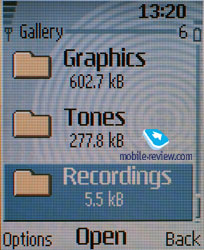 
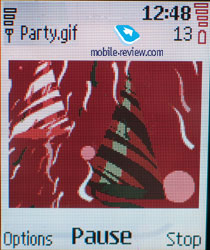 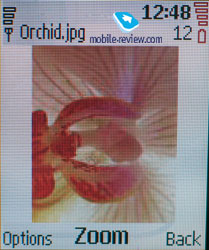
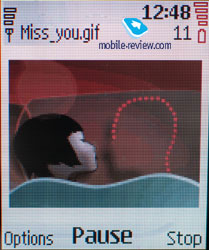 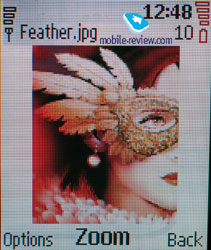
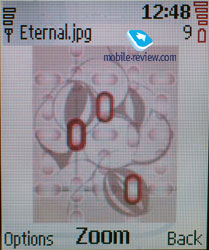 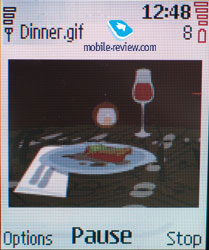
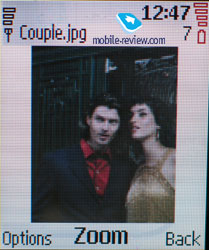 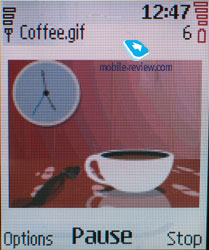
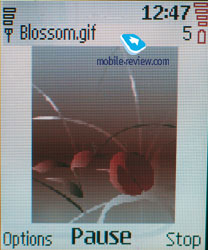 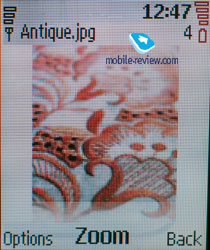
Media. In this part all the settings connected with multimedia capabilities of the device are gathered, let's start considering them from the Camera. The integrated camera allows to take photos with VGA resolution and in the portrait mode. (80x96 pixels). The quality of the pictures on the screen is average. After transmitting them on a PC they do not get worse but still not very good. The settings of the camera are ascetic, there is a night shooting mode, three types of quality and compression levels. The files are stored as JPG.

Photo samples (630 KB, ZIP)
There is a possibility to record video using the device and these are 3GP clips with the duration of 15 seconds (the resolution of 128x96 pixels, with sound - AMR). You may set the maximum duration of a clip and then have a possibility to record for up to several minutes (0.7 MB and it is 2 minutes). The quality is average, the sound matches the pronounced words seldom. On a PC the clips look not very good also and it is more an entertaining function of the device.
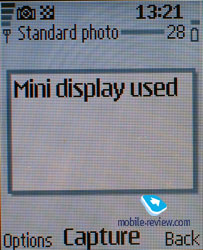 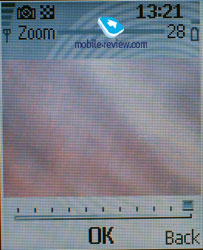
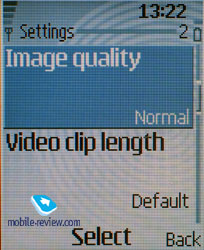
Video sample 1 (68 KB, 3GP)
Video sample 2 (108 KB, 3GP)
Video sample 3 (180 KB, 3GP)
Video sample 4 (200 KB, 3GP)
Media Player is a plain application for playing multimedia files, a tag for mp3 compositions is not shown wholly. There are no playlists but it's unnecessary with such memory.
A dictaphone allows to record up to 3 minutes of speech and works during the conversation. The number of entries is limited only by the free space in the memory.
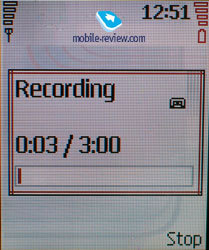
Radio. The device allows saving up to 20 FM-stations and set text names for them. The function is similar to other devices by Nokia. And switching the saved radio stations using a button on the headset is possible. The radio may work in the loudspeaker mode but attaching the headset is necessary since it services as an antenna. Radio signal also may serve as an alarm signal but the headset is necessary again. A nice stereo headset just like the one we saw in Nokia 7280 is included into the kit.
Organizer. You may keep from 100 to 250 entries in the memory and everything depends on their length, there is an automatic erasing of the old entries (by the time characteristic). There is a month and week view of the calendar, the last view has a division into hours, there is a quick switch to an entered date. There is a possibility to enter up to 5 different events (meeting, call, birthday, reminder, memo). A notification may be assigned to an event, they may be recurrent.
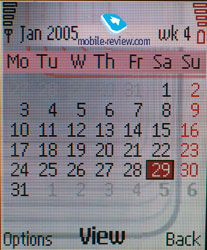 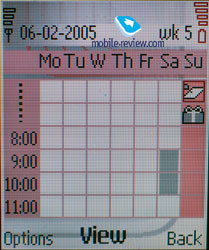
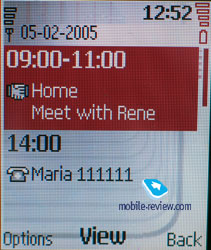 
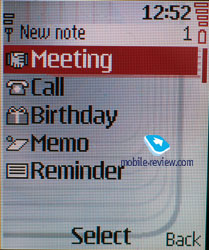
A to-do list allows to create events with three priorities (high, normal and low), and set a critical date for every event.
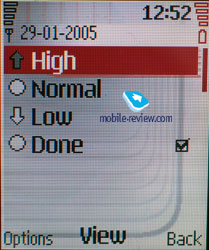
Every note may contain up to 3000 characters, in general it is more than enough even for the most fastidious user. Two different font sizes are supported like in messages.
 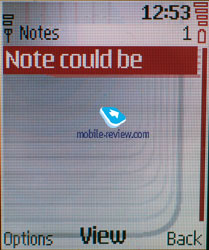
An alarm clock allows to set both once or recurrent signal.
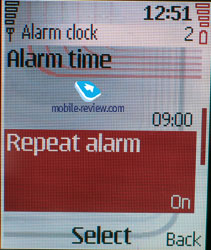 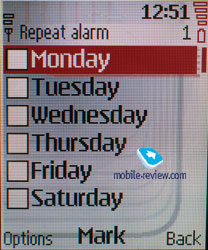
Electronic Wallet is the place where the most important information may be kept protected with a password. For instance, the data about your credit cards. On the other hand it won't be very difficult to get the information if you loose the phone and that is why you'd better keep there only the most necessary.

Standard functions like a calculator, countdown timer and a stopwatch (with intermediate results) are also present here.
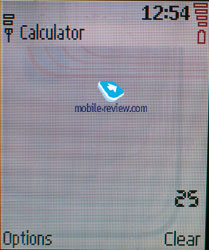
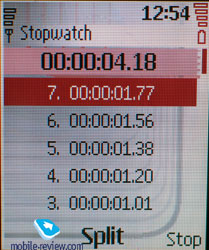
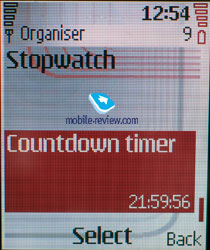
Push to Talk. There is a standard realization for Nokia phones. Top right button is responsible for the function. I have nothing special to say about it.

Applications. All the preinstalled Java applications are here. In particular these are English, French, German, Spain and Italian dictionaries. The second application is an international body size converter that will be useful when traveling.
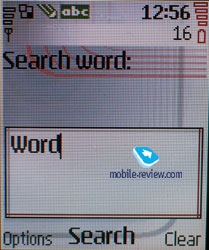
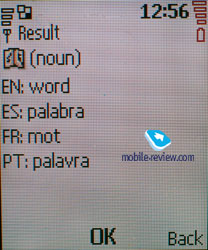

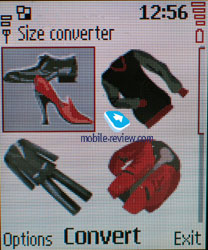
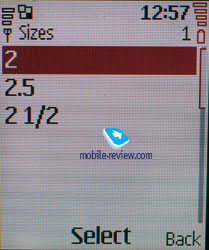
There are two games in the phone - Disco, Chic Pinball.
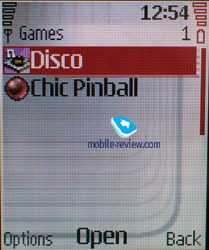
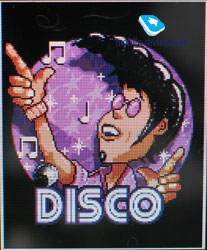
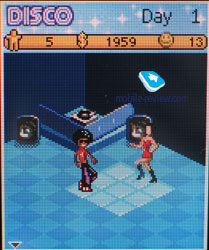
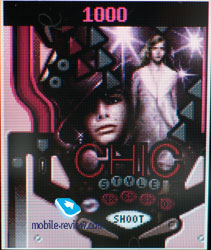
Services. Wap browser version 2.0 is hidden here. The peculiarity of the phone is that there is only a possibility to set the access point in the GPRS settings and choosing it is possible from a profile for the wap-browser. All other settings have to be either loaded to the phone from the beginning or provided by the operator via a network.
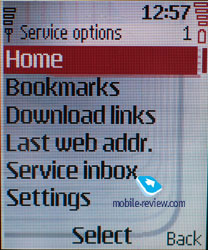
Productivity. According to the Jbenchmark 2.0 test the score for the device is 269. And this is a bit less than for Nokia 6230 but much more than for all the rival phones of the same class and 5 points higher than for Nokia 6170. The phone seems to be a champion in this parameter.
Synchronization with PC. The device supports working with a standard Nokia Suite even using an IrDA. The presence of EGDE doesn't seem necessary, for the moment of the commercial appearance of the service with an acceptable price the majority of people will already have bought other devices.

Impressions
The volume of the polyphonic call signal is comparatively high and the device is heard almost everywhere. At the same time the power of the vibra is average and that's not clear whether that is the size of the device or the working scheme for the vibra that tells upon. It's curious the manufacturer tells about 40-tones polyphony in the device but compared with Korean manufacturers the device sounds not as well. Maybe the problem is in the used memory bank with special instruments but the fact remains. A call signal is a weak point of Nokia devices. New melodies will sound differently to what you expect. So, we offer to use mp3 compositions that sound louder and clear.


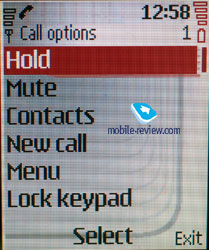
The model is average even middling in possibilities and has only a garish appearance but not any great number of fashion functions. We told Nokia 6170 was a working horse and here the same device is represented as a fashion phone. An evident minus is that the model is mainly for men since women will find it hard to deal with the device due to the size. Better componentry and more memory make Nokia 7270 seem more attractive than 6170. That tells on the price that is 100 USD higher and the difference of these 100 USD will remain all the time. So, in the beginning of the sales Nokia 7270 costs 450 USD and the price will hardly fall in the nearest future.

That's curious the poll in our forum showed that Nokia 7270 is considered the most attractive model of the Art-Deco line. And that allows thinking there is a niche for similar devices in the market. I'd like to add though the phone is intended as a fashion model (and really is considering the price) it actually is a good working horse. The absence of Bluetooth is the main drawback and it would be really necessary here. And in general the phone makes quite a pleasant impression.

P.S. When writing the last lines I though about comparing the phone with Motorola V3 Razr. The devices are comparable functionally though refer to different classes. In both cases the manufacturer stakes on the design and less on functionality. Just think some people like thin devices and some ones like the feeling of reliability and mass in a hand. Tastes differ and the manufacturers try to satisfy them all. To decline the disputes I'll note Motorola V3 is a device of a higher level due to the price and positioning. This comparison is not very correct but acceptable due to the explanation above.
Links on the topic:
Eldar Murtazin (eldar@mobile-review.com)
Translated by Maria Mitina (maria.mitina@mobile-review.com)
Published — 4 February 2005
Have something to add?! Write us... eldar@mobile-review.com
|

































































































